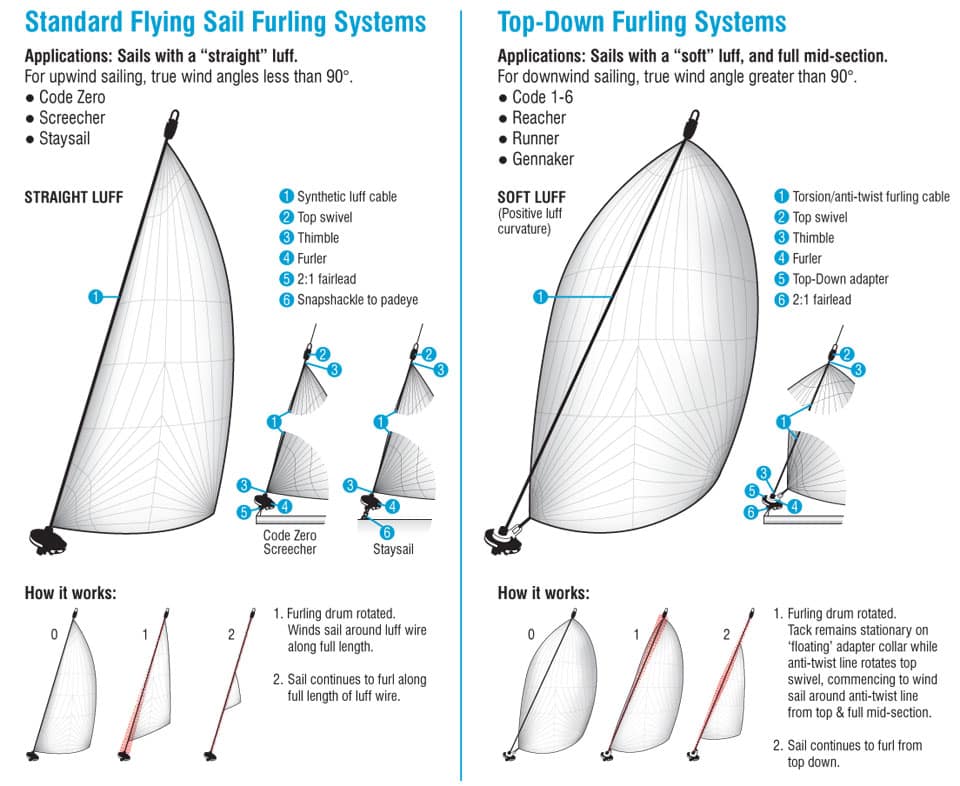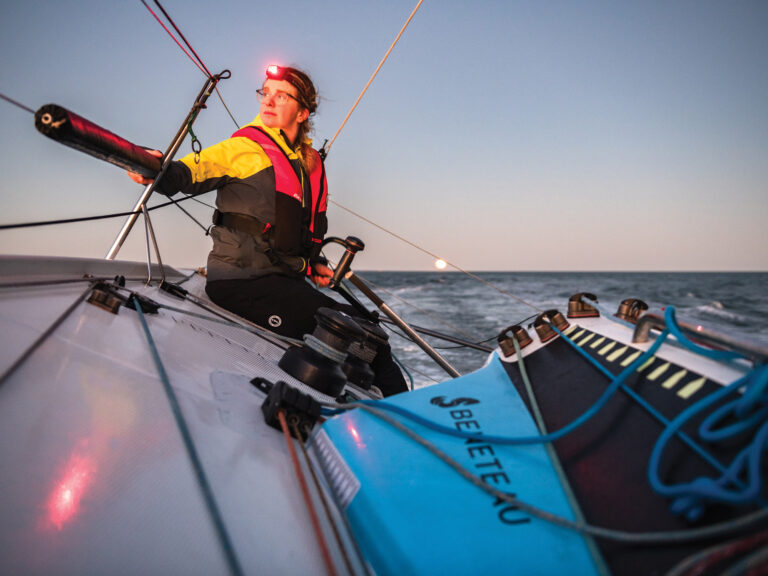
furler info
For many years, the standard technique for handling cruising spinnakers has been the ubiquitous and often awkward “sock,” which is a way to deploy and strike a spinnaker in a controlled manner, especially when sailing shorthanded. This has also been the case in the shorthanded and buoy-racing scene: Either socks or wools are required to keep all that sailcloth under control as spinnakers go up and down. In the higher realm of grand-prix racing, to maximize sail shape and usage, the standard has been to simply douse the spinnaker with all-hands forward, and therefore not use a sock. More recently, string-drop systems have come into favor, where a drop line attached somewhere in the middle of the sail is run to either a drum, winch, or purchase system to pull the sail into the forward hatch.
Today, at the top of the grand-prix scene, there has been an important advancement on the furling front: top-down furlers. These systems allow you to roll asymmetric spinnakers as simply as you would a jib on a roller furler. The potential advantages for a racing team, either around the buoys or offshore, include simplifying sail changes and eliminating the need to continuously band or pack spinnakers.
A top-down furler operates just as its name implies. It furls the asymmetric spinnaker, or gennaker, from the head down. The bottom portion of the sail is rolled last. The engineering that makes this possible is a free-floating swivel on top of the furling drum to which the sail is tacked. The tack, foot, and bottom portion of the sail remain unfurled as the head and top start a tight furl around an anti-torsion cable. This anti-torsion cable is the critical piece of the system, and the one that has undergone the most significant development. The anti-torsion cable is a fiber cable that runs from the top swivel to the furling drum. It is engineered not to twist as the sail is furled, therefore allowing the entire assembly to turn in unison. As opposed to a traditional headsail furling system, a top-down furling system keeps the sail separate from the cable, and twists—or furls—around it. The head of the sail is attached, usually lashed, to a thimble integrated into the top of the cable.
Retrofitting existing furling assemblies to a top-down setup only requires a few items. Only one furler assembly is required—drum and top swivel—regardless of how many asymmetric spinnakers or code zeros are in the sail inventory. Each sail, however, requires its own anti-torsion cable. These are made by several manufacturers to order, such as Composite Rigging and Future Fibres. However, for boats up to around 50 feet, we make them in-house at West Marine Newport, using a product from Marlow called ProDrive, which is made from a Vectran parallel core, and a Kevlar wrapped polyester cover. The ProDrive and other cables are considerably light and pliable, so they’re easy to manage on the boat.
Two popular off-the-shelf systems are available from Ronstan and Karver, and their units are very similar in design and components. The primary, non-aesthetic differences between the two systems are with the drum swivel itself and the furler-line cage. Another difference is with the furler line. With the Ronstan unit, the line must be spliced onto the furler. It’s not removable.
The Karver unit has a notched design in the line cage to allow a spliced continuous furler line to be laid in the drum and also taken out. This allows you to use the same furling line with multiple drums, or have the line spliced into a system on the boat, while allowing the drum to be removed from the deck. Ronstan offers a conversion kit that turns its code zero furler into a top-down furler, while Karver does not have a conversion kit. The Ronstan conversion kit costs around $1,100 and the Karver KSF2, which is a complete furling system, lists at $2,250. For a 40-foot boat, a finished ProDrive cable, including the lashing thimbles, would cost around $600.
For launching, the sail is furled down below, preferably in a spinnaker turtle. When it’s time to set, simply attach the head thimble into the top swivel, which is on a halyard. Attach the tack thimble into the furler drum, which goes on a tack line just like an asymmetric sail. Then deploy the tack line and hoist the halyard as normal. Raise the spinnaker until taut, and sheet on to deploy the sail. The cable will take on some load, mostly to keep it tight.
Basically the same problems that could befall you with any furler—a bad furl, or unfurl—apply to a top-down furler as well, but if care is taken during the furl to control the rate of cloth going into the furl, it can work flawlessly. From my experience thus far, the key is to turn downwind briefly, make sure the top of the sail starts with a nice, tight roll, and then a slight turn up to keep tension on the sheet to prevent too much of the middle of the sail from being pulled in all at once. If the sail is uniformally rolled from top to bottom, you should have no problems. The halyard can then be lowered at a controlled rate, allowing the sail to fall to the foredeck and be snaked into a spinnaker turtle, disconnected, and stowed, without any need to send a crewmember belowdecks to band.
The simplicity and reliability of this new system is catching on, so expect to see more 40-foot-plus race boats using them, especially for offshore races. Top-down furling makes hoists easy and douses drama-free, allowing you to get around the mark while avoiding all-hands-on-deck situations. Instead of having spinnaker cloth draped across the deck, you can worry about getting the “tube” down on deck while you are dialed in heading upwind.









